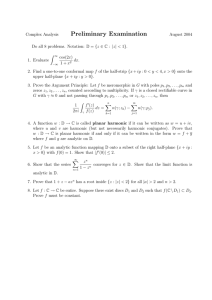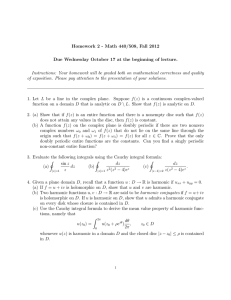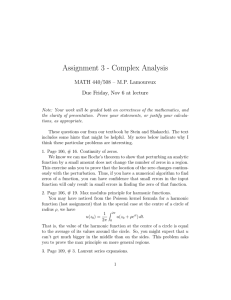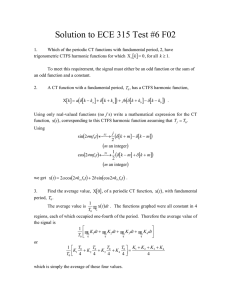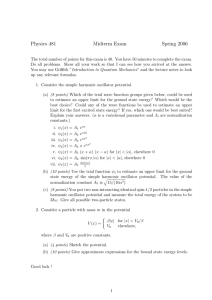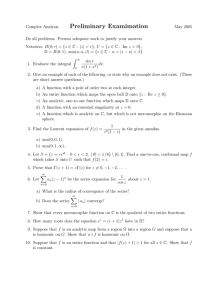Document 12675017
advertisement
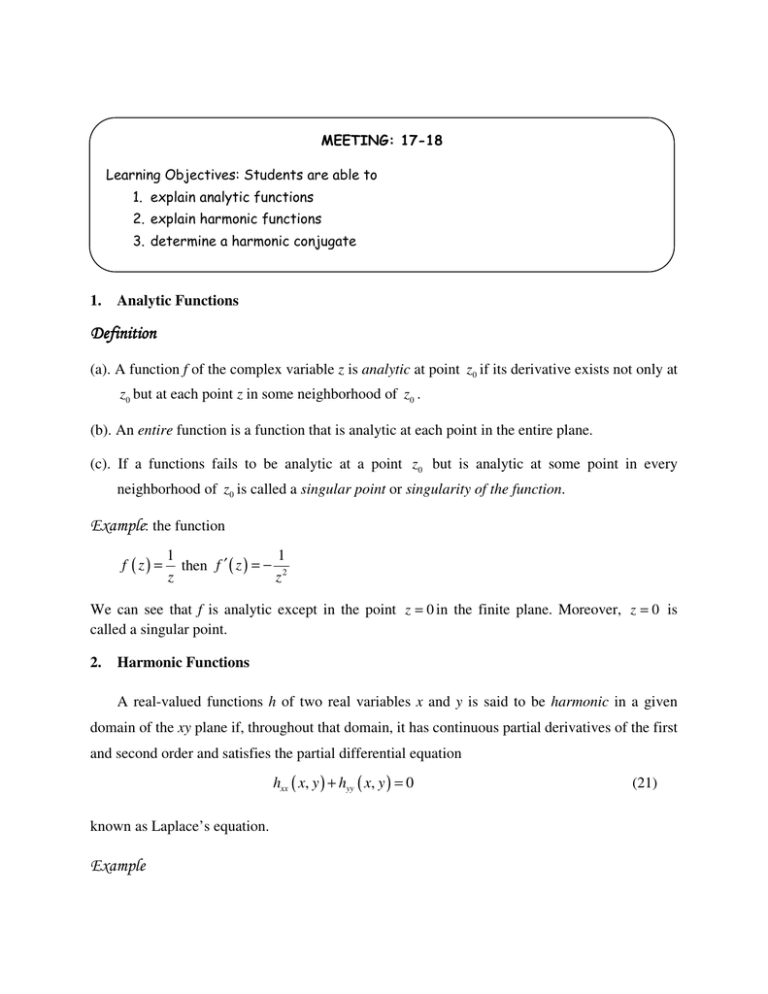
MEETING: 17-18 Learning Objectives: Students are able to 1. explain analytic functions 2. explain harmonic functions 3. determine a harmonic conjugate 1. Analytic Functions Definition (a). A function f of the complex variable z is analytic at point z0 if its derivative exists not only at z0 but at each point z in some neighborhood of z0 . (b). An entire function is a function that is analytic at each point in the entire plane. (c). If a functions fails to be analytic at a point z0 but is analytic at some point in every neighborhood of z0 is called a singular point or singularity of the function. Example: the function f ( z) = 1 1 then f ′ ( z ) = − 2 z z We can see that f is analytic except in the point z = 0 in the finite plane. Moreover, z = 0 is called a singular point. 2. Harmonic Functions A real-valued functions h of two real variables x and y is said to be harmonic in a given domain of the xy plane if, throughout that domain, it has continuous partial derivatives of the first and second order and satisfies the partial differential equation hxx ( x, y ) + hyy ( x, y ) = 0 known as Laplace’s equation. Example (21) The function H ( x, y ) = e− y sin x is harmonic since H x = e − y cos x , H xx = −e − y sin x , H y = −e− y sin x , H yy = e− y sin x and H xx ( x, y ) + H yy ( x, y ) = 0 3. Harmonic Conjugate If two given functions u and v are harmonic in a domain D and their first partial derivatives satisfy the Cauchy-Riemann equations throughout D, we say that v is a harmonic conjugate of u. We now illustrate one method of obtaining a harmonic conjugate of a given harmonic function. The function u ( x, y ) = y3 − 3x 2 y . To find a harmonic conjugate v ( x, y ) , we note that u x ( x, y ) = −6 xy . So, in view of the condition u x = v y we may write v y = −6 xy . Holding x fixed and integrating both sides of this equation with respect to y, we find that v ( x, y ) = −3xy 2 + g ( x ) where g ( x ) is arbitrary function of x. Since the condition u y = −vx must hold, it follows that 3 y 2 − 3x 2 = 3 y 2 − g ′ ( x ) So, g ′ ( x ) = 3x 2 , and this means that g ( x ) = x3 + c , where c is an arbitrary real number. Hence the function v ( x, y ) = x3 − 3xy 2 + c is a harmonic conjugate of our function. The corresponding analytic function is f ( z ) = ( y 3 − 3 x 2 y ) + i ( x 3 − 3 xy 2 + c ) It is easily verified that f ( z ) = i ( z3 + c) Exercises: 1. In each case, determine the singular points of the functions and state why the function is analytic everywhere except at those points a. f ( z) = z +1 z ( z2 + 2) b. f ( z) = z z − 2iz + 3 2 2. Show that the following functions are entire a. f ( z ) = cosh x sin y − i sinh x cos y b. g ( z ) = cosh x cos y + i sinh x sin y 3. Let a, b and c be real constants. Determine a relation among the coefficients that will guarantee that the function f ( x, y ) = ax 2 + bxy + cy 2 is harmonic. 4. Show that u ( x, y ) is harmonic in some domain and find a harmonic conjugate v ( x, y ) when a. u ( x, y ) = 2 x (1 − y ) b. u ( x, y ) = 2 x − x3 + 3 xy 2 5. Let u1 ( x, y ) = x 2 − y 2 and u2 ( x, y ) = x3 − 3xy 2 . Show that u1 and u2 are harmonic functions and that their product u1 ( x, y ) .u2 ( x, y ) is not a harmonic function.
